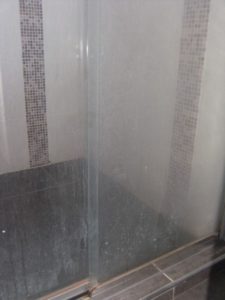WHAT IS SILICA?
Silica is a collective term that encompasses all reactive and inert forms of the chemically resistant dioxide SiO2 of silicon or silicates. It is formed from silicon and oxygen in combination with one or more minerals or metals. Silica, such as quartz, is present in most of the earth's minerals. Silica is a hard, glassy-like mineral that is found dissolved in water as a result from the bedrock it passes through, like sandstone and granite. In well and surface water, it can range from 1-100 parts per million as dissolved (reactive) or undissolved (colloidal) silica.
Due to its physical characteristics, silica in water can cause scratching, etching, or water spotting on glassware and fixtures. Water-spotting presents itself as a sometimes cloudy, milk-like film, spots, or streaks left on a surface after the water has evaporated. In scenarios of soft water, silica is often the reason for staining and scratching and is more easily identified. In hard water scenarios, silica can be harder to identify as a potential problem because of the similarities between the physical characteristics of hard water and silica water spotting or etching. An easy way to determine between silica and hard water stains is by using an acid like vinegar to clean the stains. Vinegar, being acidic, will dissolve and clean hard water stains containing calcium and magnesium scaling. If the stains or streaks remain, it can often indicate the presence of silica in the water.
SILICA REMOVAL
There are multiple treatment options available for removing silica from water. Determining which removal process is most appropriate is dependent on whether the silica is in a dissolved or colloidal form. Dissolved silica is best removed through reverse osmosis, while colloidal silica is best removed through ultrafiltration. It is always important to have your water tested for silica by a laboratory, in order to determine both the concentration and state of the silica present.
ULTRAFILTRATION
The most cost-effective and low maintenance option for silica reduction is ultrafiltration (UF). However, UF will only reduce colloidal silica. The UF membrane functions as a filter to separate the colloidal silica from the water. UF can provide high treated water flow rates, and takes up significantly less floor space than a Point-Of-Entry Reverse Osmosis (POE RO) system. Even better, UF systems can potentially operate at extremely high efficiencies (up to 99% recovery). Pilot testing using a Master Water UF Pilot Stick is a simple and reliable method for validating the efficacy of a full scale UltraPro system, and can be used to easily differentiate between reactive and colloidal silica.
REVERSE OSMOSIS
If reactive silica is present in the water, reverse osmosis (R.O.) is the most appropriate treatment approach in a residential environment. Due to the extremely tight filtration of the R.O. membrane (0.0001 micron), the membrane separates the silica from the water. R.O. will reduce both reactive and colloidal silica. However, R.O.'s often require extensive pre-treatment. Additionally, R.O.'s tend to produce water at a very low rate. Therefore, extensive atmospheric storage and repressurization is typically required. With all this in mind, Point-Of-Entry (POE) R.O. systems can be rather costly. Hence the importance of differentiating between reactive and colloidal silica.
ION EXCHANGE
The third most common treatment option for silica is ion exchange. Silica molecules carry a negative charge, and therefore require an anion resin to reduce them. Arguably the biggest problem with an anion exchange approach, is that the resin will require regeneration with a caustic soda (NaOH) solution. During regeneration, the silica molecules are exchanged with hydroxide (OH) ions on the resin, as opposed to typical cation exchange softeners that exchange sodium for other cations, such as calcium. Often times, anion exchange silica removal units require some pre-treatment (i.e. filtration/cation exchange softener), and are typically installed as a "polisher." Since the anion resin is in the hydroxide form, the treated water pH is typically very high. Therefore, pH reduction is often required after the silica reduction step. This is a result of the characteristics of the anion resin, and is dependent on the influent water chemistry. Between the safety concerns of the need to use caustic soda, and the complexity of the anion resin approach for silica, it is typically not recommended for residential applications.










